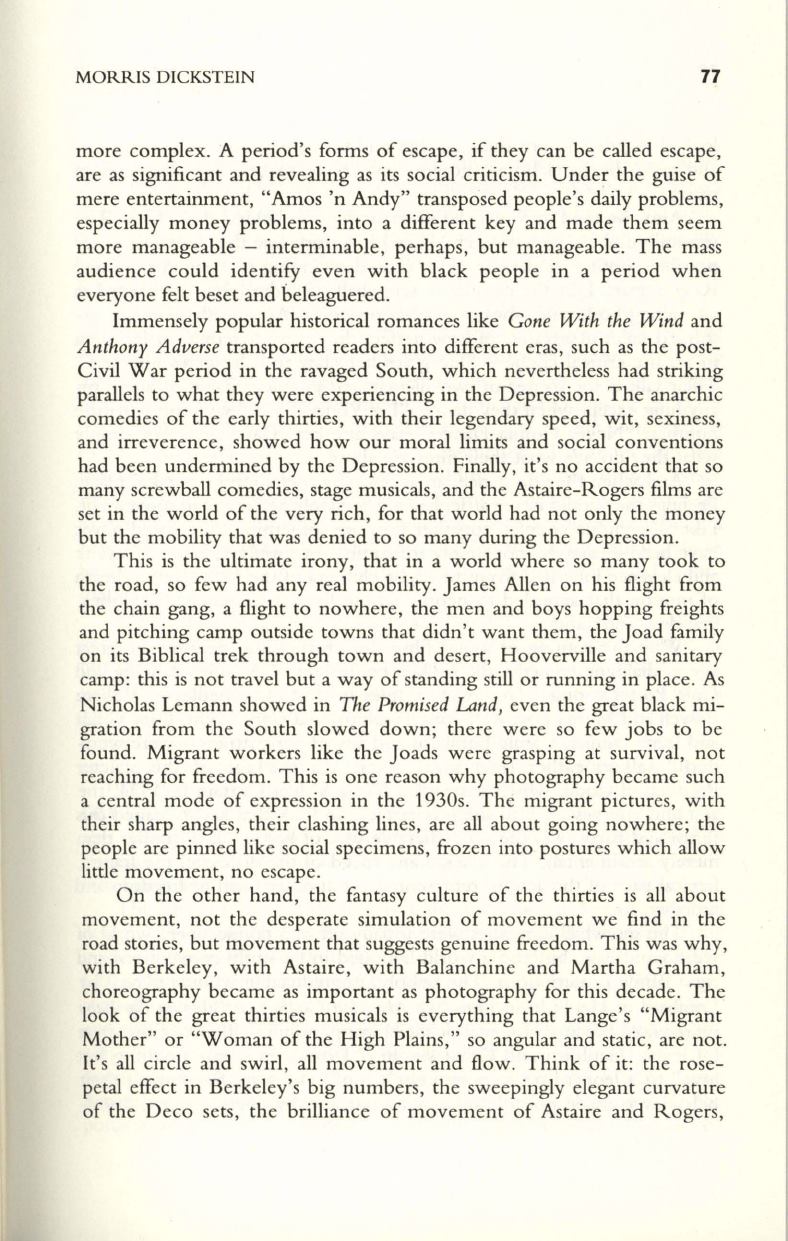
MORRIS DICKSTEIN
77
more complex. A period's forms of escape, if they can be called escape,
are as significant and revealing as its social criticism. Under the guise of
mere entertainment, "Amos 'n Andy" transposed people's daily problems,
especially money problems, into a different key and made them seem
more manageable - interminable, perhaps, but manageable. The mass
audience could identify even with black people in a period when
everyone felt beset and beleaguered.
Immensely popular historical romances like
Cone With the Wind
and
Anthony Adverse
transported readers into different eras, such as the post–
Civil War period in the ravaged South, which nevertheless had striking
parallels to what they were experiencing in the Depression. The anarchic
comedies of the early thirties, with their legendary speed, wit, sexiness,
and irreverence, showed how our moral limits and social conventions
had been undermined by the Depression. Finally, it's no accident that so
many screwball comedies, stage musicals, and the Astaire-Rogers films are
set in the world of the very rich, for that world had not only the money
but the mobility that was denied to so many during the Depression.
This is the ultimate irony, that in a world where so many took to
the road, so few had any real mobility. James Allen on his flight from
the chain gang, a flight to nowhere, the men and boys hopping freights
and pitching camp outside towns that didn't want them, the Joad family
on its Biblical trek through town and desert, Hooverville and sanitary
camp: this is not travel but a way of standing still or running in place. As
Nicholas Lemann showed in
The Promised Land,
even the great black mi–
gration from the South slowed down; there were so few jobs to be
found. Migrant workers like the Joads were grasping at survival, not
reaching for freedom. This is one reason why photography became such
a central mode of expression in the 1930s. The migrant pictures, with
their sharp angles, their clashing lines, are all about going nowhere; the
people are pinned like social specimens, frozen into postures which allow
little movement, no escape.
On the other hand, the fantasy culture of the thirties is all about
movement, not the desperate simulation of movement we find in the
road stories, but movement that suggests genuine freedom. This was why,
with Berkeley, with Astaire, with Balanchine and Martha Graham,
choreography became as important as photography for this decade. The
look of the great thirties musicals is everything that Lange's "Migrant
Mother" or "Woman of the High Plains," so angular and static, are not.
It's all circle and swirl, all movement and flow. Think of it: the rose–
petal effect in Berkeley's big numbers, the sweepingly elegant curvature
of the Deco sets, the brilliance of movement of Astaire and Rogers,


